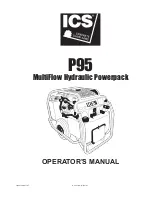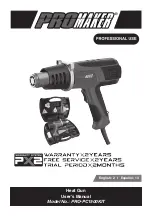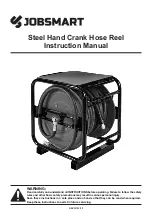
11
There are three available systems on the FCN90B, FCN90L, FCN90LB, SCN90L & PN90:
1. CONTACT TRIP OPERATION (RAPID FIRE):
To operate the tool in this manner, hold the tool with the contact trip pointing towards but not touching the work
surface. Pull the trigger and then tap the contact trip against the work surface using a bouncing motion. Each
depression of the contact trip will cause a fastener to be driven.
2. SEQUENTIAL TRIP OPERATION (SINGLE FIRE):
To operate the tool in this manner, first position the contact trip on the work surface,
WITHOUT PULLING THE
TRIGGER. Depress the contact trip until the nose touches the work surface and then pull the trigger to drive a
fastener. Do not press the tool against the work with extra force. Instead, allow the tool to recoil off the work surface
to avoid a second unwanted fastener. Remove your finger from the trigger after each operation
3. REMOTE FIRE:
The Remote fire model is cycle by actuation of remote valve (RCVA1) for mounted machine.
There is one available system on the FCN90:
1. SMART TRIGGER OPERATION:
CONTINUOUS BUMP FIRE OPERATION
WITH SMART TRIGGER
The common operating procedure on “Contact Trip” tools is for the operator to contact the work to actuate the trip
mechanism while keeping the trigger pulled, thus driving a fastener each time the work is contacted. This will
allow rapid fastener placement on many jobs, such as sheathing, decking and pallet assembly. All pneumatic
tools are subject to recoil when driving fasteners. The tool may bounce, releasing the trip, and if unintentionally
allowed to recontact the work surface with the trigger still actuated (finger still holding trigger pulled) an unwanted
second fastener will be driven.
SINGLE SEQUENTIAL FIRE OPERATION WITH SMART TRIGGER
For single fire operation, depress the Contact Arm against the work piece and pull the Trigger. Tool cannot fire a
second nail until the Trigger is released and tool can cycle.
DRIVING DEPTH ADJUSTMENT DIAL (FCN90(B), FCN90LB & SCN90L)
ALWAYS discount air supply before Adjustment dial.
1. With air pressure set, drive nails into a representative
material sample to determine if adjustment is necessary.
2. If adjustment is required, disconnect air supply.
3. Refer to the mark on the Contact Arm area for direction to
turn the Adjustment dial.
4. Reconnect air supply.
10
LOADING THE TOOL:
Open the magazine:
Pull down door latch and swing door
open. Open the magazine.
Nail length adjustment:
The nail support can be moved
up and down to four settings. To change
setting pull up on the post and twist to
the correct step. The nail support should
be adjusted correctly to the position
indicated in inches and millimeters inside
magazine.
Nail loading:
Place a coil of nails over the post in the
magazine. Uncoil enough nails to reach the feed
pawl, and place the second nail between the
teeth on the feed pawl. The nail heads fit in slot
on nose.
Swing Cover Closed
Check that latch engages. (If it does not engage,
Close the door
: check that the nail heads are in the slot on the
nose.)
TOOL OPERATION
EYE PROTECTION which conforms to ANSI/ CE specifications and provides protection against
flying particles both from the FRONT and SIDE should ALWAYS be worn by the operator and others
in the work area when connecting to air supply, loading, operating or servicing this tool. Eye
protection is required to guard against flying fasteners and debris, which could cause severe eye
injury.
The employer and/or user must ensure that proper eye protection is worn. Eye protection
equipment must conform to the requirements of the ANSI Z87.1 and 89/686/EEC, and provide both
frontal and side protection. NOTE: Non-side shielded spectacles and face shields alone do not
provide adequate protection.
BEFORE HANDLING OR OPERATING THIS TOOL:
READ AND UNDERSTAND THE WARNINGS CONTAINED IN THIS MANUAL.
REFER TO “TOOL SPECIFICATIONS” IN THIS MANUAL TO IDENTIFY THE OPERATING
SYSTEM ON YOUR TOOL.
The operator must not hold the trigger on contact trip tools except during
fastening operation, as serious injury could result if the trip accidentally
contacts someone or something, causing the tool to cycle.
Keep hands and body away from the discharge area of the tool. A contact trip
tool may bounce from the recoil of driving a fastener and an unwanted second
fastener may be driven, possibly causing injury.
































